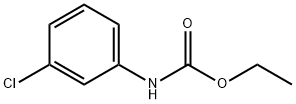BARBAN
- CAS NO.:101-27-9
- Empirical Formula: C11H9Cl2NO2
- Molecular Weight: 258.1
- MDL number: MFCD00045297
- EINECS: 202-930-4
- SAFETY DATA SHEET (SDS)
- Update Date: 2023-04-23 13:52:06

What is BARBAN?
Chemical properties
Crystalline solid; melts at 75°C (167°F);insoluble in water [11 mg/L at 25°C (77°F)];slightly soluble in hexane; soluble in benzeneand chlorinated hydrocarbons.
Chemical properties
Whitecrystallinesolid;meltsat75°C(167°F);insoluble in water, dissolves in benzene,toluene, and ethylene dichloride; hydrolyzedby acids and alkalies; alkaline hydrolysis liberates terminal chlorine atom.
The Uses of BARBAN
Barban is used as a selective herbicide forwild oats.
The Uses of BARBAN
Selective herbicide for wild oats.
Definition
ChEBI: A carbamate ester that is 4-chlorobut-2-yn-1-yl ester of N-(3-chlorophenyl)carbamic acid. A herbicide, it is no longer approved for use within the European Community.
General Description
Crystalline solid. Water solubility is 11 ppm at 20°C. Used as a selective herbicide.
Air & Water Reactions
Hydrolyzed by strong acid or base.
Reactivity Profile
BARBAN is a carbamate ester. Carbamates are chemically similar to, but more reactive than amides. Like amides they form polymers such as polyurethane resins. Carbamates are incompatible with strong acids and bases, and especially incompatible with strong reducing agents such as hydrides. Flammable gaseous hydrogen is produced by the combination of active metals or nitrides with carbamates. Strongly oxidizing acids, peroxides, and hydroperoxides are incompatible with carbamates.
Health Hazard
Moderately toxic by ingestion and inhalation;absorption through skin may be very slowand, therefore, almost nontoxic by dermalroute; used as a herbicide, rather than as apesticide; toxic symptoms are those of othercarbamate esters;
LD50 oral (rat): 600 mg/kg
LD50 skin (rabbit): >20,000 mg/kg.
Properties of BARBAN
| Melting point: | 75-76℃ |
| Boiling point: | 340.8±32.0 °C(Predicted) |
| Density | 1.403 |
| refractive index | 1.6070 (estimate) |
| storage temp. | 0-6°C |
| pka | 12.30±0.70(Predicted) |
| form | Powder/Solid |
| color | White |
| Water Solubility | 11mg/L(25 ºC) |
| Merck | 13,962 |
| BRN | 2376181 |
| EPA Substance Registry System | Barban (101-27-9) |
Safety information for BARBAN
| Signal word | Warning |
| Pictogram(s) |
 Exclamation Mark Irritant GHS07  Environment GHS09 |
| GHS Hazard Statements |
H302:Acute toxicity,oral H317:Sensitisation, Skin H410:Hazardous to the aquatic environment, long-term hazard |
| Precautionary Statement Codes |
P273:Avoid release to the environment. P280:Wear protective gloves/protective clothing/eye protection/face protection. P501:Dispose of contents/container to..… |
Computed Descriptors for BARBAN
New Products
4-AMINO-TETRAHYDRO-PYRAN-4-CARBOXYLIC ACID HCL 4-(Dimethylamino)tetrahydro-2H-pyran-4-carbonitrile 4-Aminotetrahydropyran-4-carbonitrile Hydrochloride (R)-3-Aminobutanenitrile Hydrochloride 3-((Dimethylamino)methyl)-5-methylhexan-2-one oxalate 1,4-Dioxa-8-azaspiro[4.5]decane 5-Bromo-2-nitropyridine Nimesulide BP Aceclofenac IP/BP/EP Diclofenac Sodium IP/BP/EP/USP Mefenamic Acid IP/BP/EP/USP Ornidazole IP Diclofenac Potassium THOMAIND PAPER PH 2.0 TO 4.5 1 BOX BUFFER CAPSULE PH 9.2 - 10 CAP SODIUM CHLORIDE 0.1N CVS ALLOXAN MONOHYDRATE 98% PLATINUM 0.5% ON 3 MM ALUMINA PELLETS (TYPE 73) LITHIUM AAS SOLUTION 2-Bromo-1-(bromomethyl)-3-chloro-5-nitrobenzene 2-Bromo-3-nitroaniline N-(3-Hydroxypropyl)-N-methylacetamide 3-Bromo-6-chloropyridazine 4-ethyl-3-nitrobenzoic acidRelated products of tetrahydrofuran








You may like
-
 1-Methyl-6-oxo-1,6-dihydropyridazine-3-carbonitrile 98%View Details
1-Methyl-6-oxo-1,6-dihydropyridazine-3-carbonitrile 98%View Details
99903-60-3 -
 88491-46-7 98%View Details
88491-46-7 98%View Details
88491-46-7 -
 1823368-42-8 98%View Details
1823368-42-8 98%View Details
1823368-42-8 -
 2-(3-(tert-butyl)phenoxy)-2-methylpropanoic acid 1307449-08-6 98%View Details
2-(3-(tert-butyl)phenoxy)-2-methylpropanoic acid 1307449-08-6 98%View Details
1307449-08-6 -
 Ethyl 3-(furan-2-yl)-3-hydroxypropanoate 25408-95-1 98%View Details
Ethyl 3-(furan-2-yl)-3-hydroxypropanoate 25408-95-1 98%View Details
25408-95-1 -
 2-Chloro-5-fluoro-1-methoxy-3-methylbenzene 98%View Details
2-Chloro-5-fluoro-1-methoxy-3-methylbenzene 98%View Details
1805639-70-6 -
 1784294-80-9 98%View Details
1784294-80-9 98%View Details
1784294-80-9 -
 Lithium ClavulanateView Details
Lithium ClavulanateView Details
61177-44-4